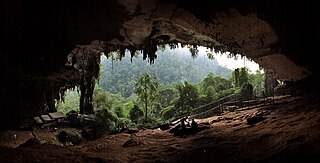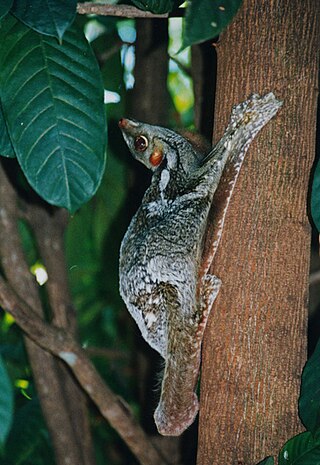
Mount Kinabalu is the highest mountain in Borneo and Malaysia. With an elevation of 4,095 metres (13,435 ft), it is the third-highest peak of an island on Earth, the 28th highest peak in Southeast Asia, and 20th most prominent mountain in the world. The mountain is located in Ranau district, West Coast Division of Sabah, Malaysia. It is protected as Kinabalu Park, a World Heritage Site.

The Wallace line or Wallace's line is a faunal boundary line drawn in 1859 by the British naturalist Alfred Russel Wallace and named by the English biologist T.H. Huxley that separates the biogeographical realms of Asia and 'Wallacea', a transitional zone between Asia and Australia also called the Malay Archipelago and the Indo-Australian Archipelago. To the west of the line are found organisms related to Asiatic species; to the east, a mixture of species of Asian and Australian origins is present. Wallace noticed this clear division in both land mammals and birds during his travels through the East Indies in the 19th century.

Sundaland is a biogeographical region of South-eastern Asia corresponding to a larger landmass that was exposed throughout the last 2.6 million years during periods when sea levels were lower. It includes Bali, Borneo, Java, and Sumatra in Indonesia, and their surrounding small islands, as well as the Malay Peninsula on the Asian mainland.

Mount Tambuyukon or Tamboyukon is a mountain located at the West Coast and Kudat divisions of Sabah, Malaysia. It is considered the third-highest mountain in the country with height at 2,579 metres (8,461 ft), lying north of the highest Mount Kinabalu.

Niah National Park, located within Miri Division, Sarawak, Malaysia, is the site of the Niah Caves which are an archeological site.

The tailless fruit bat is a species of fruit bat in the family Pteropodidae.

The pygmy fruit bat, also known as the grey fruit bat, is a species of megabat.

The black-capped fruit bat is a species of megabat in the monotypic genus Chironax.

The long-tongued nectar bat, also known as the northern blossom bat, honey nectar bat, least blossom-bat, dagger-toothed long-nosed fruit bat, and lesser long-tongued fruit bat, is a species of megabat. M. minimus is one of the smallest species in the family Pteropodidae, with an average length of 60–85 mm. It has a reddish-brown colouring with relatively long hair compared to the other species. The hair on the abdomen is a lighter colour, and a dark brown stripe runs bilaterally down the top of the head and back.

The dayak fruit bat or dyak fruit bat is a relatively rare frugivorous megabat species found only on the Sunda Shelf of southeast Asia, specifically the Malay Peninsula south of the Isthmus of Kra, and the islands of Borneo and Sumatra. There are three species in the genus Dyacopterus: D. spadiceus, D. brooksi and D. rickarti. All are found in the forests of Malaysia, Thailand, and the Philippines. Few specimens of any of the three species exist, due not only to their rarity, but also because they rarely enter the sub-canopy of the forest where they can be caught in scientists' nets.

The Sunda flying lemur, Sunda colugo, Malayan flying lemur or Malayan colugo is the sole colugo species of the genus Galeopterus native to Southeast Asia ranging from southern Myanmar, Thailand, southern Vietnam, Malaysia to Singapore and Indonesia.

Mount Pueh, also known as Mount Pueh-Berumput, Mount Poi and Mount Poe, is a mountain located near Lundu, Sarawak on the Malaysia-Indonesia border. Mount Pueh was known to biologists for the collections made there by Eric Mjöberg (1882–1938), a Swedish naturalist, who was Curator of the Sarawak Museum between 1922 and 1924. Mjöberg's herpetological collections from Gunung Pueh between October and December 1923, and other localities in Borneo, were reported by Smith (1925). Mjöberg, unfortunately, left little by way of written records, of his ascent of Pueh and the collections he made.

The Sunda clouded leopard is a medium-sized wild cat native to Borneo and Sumatra. It is listed as Vulnerable on the IUCN Red List since 2015, as the total effective population probably consists of fewer than 10,000 mature individuals, with a decreasing population trend. On both Sunda Islands, it is threatened by deforestation. It was classified as a separate species, distinct from the clouded leopard in mainland Southeast Asia based on a study in 2006. Its fur is darker with a smaller cloud pattern.

The Malayan tailless leaf-nosed bat is a species of bat in the family Hipposideridae. It is a very small bat which has long and soft fur. The fur coloration is brown to blackish on the dorsal surface and ashy on the ventral surface. It can be distinguished from the other roundleaf bats by its small size and the absence of the tail. It is listed as vulnerable by the IUCN

The Borneo lowland rain forests is an ecoregion, within the tropical and subtropical moist broadleaf forests biome, of the large island of Borneo in Southeast Asia. It supports approximately 15,000 plant species, 380 bird species and several mammal species. The Borneo lowland rain forests is diminishing due to logging, hunting and conversion to commercial land use.

The Greater Sunda Islands are four tropical islands situated within the Indonesian Archipelago, in the Pacific Ocean. The islands, Borneo, Java, Sulawesi and Sumatra, are internationally recognised for their ecological diversity and rich culture. Together with the Lesser Sunda Islands to their southeast, they comprise the archipelago known as the Sunda Islands.

The Sunda leopard cat is a small wild cat species native to the Sundaland islands of Java, Bali, Borneo, Sumatra and the Philippines that is considered distinct from the leopard cat occurring in mainland South and Southeast Asia.

The Bornean tiger or Borneo tiger is possibly an extinct tiger population that lived on the island of Borneo in prehistoric times. A live Bornean tiger has not been conclusively recorded, but the indigenous Dayak people believe in its existence, and occasionally report sightings.

















